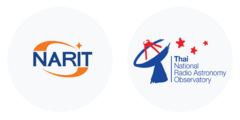1. Scheduling and Operations
All of accepted proposals will be listed in observation queue first and executed with a dynamic scheduling prepared 1-month ahead. All the observations (scientific observations in this CfP, commissioning observations, etc.) are operated by the operators in this TNRO project. Observation set-ups will be designed by user support scientists (see section "User Support") and discussed with the operators in advance. These operations will be achieved in 2-shifts basically working in 9:00 - 22:00 at Monday to Friday. These time-range for operations might be consulted to be occasionally shifted depending on scientific objectives and the requirements. This kind of operations are possibly as a contribution to RSRO type CfP in this cycle.
2. Recovery Observation
If an open use observation cannot be achieved along a dynamic scheduling due to very severe weather conditions (e.g., strong wind due to a typhoon and/or thunderstorm) and/or mechanical accidents, the TNRT Time Allocation Committee (TAC) will consider the time re-allocation of the recovery observations in other months of this CfP cycle or for the next cycle.
3. Target of Opportunity (ToO) Observation
TNRT accepts ToO observations as well. It is strongly recommended that ToO proposals (in particular expected ToO) are submitted during this CfP cycle as well. Considered that TNRT is regularly operated in 2-shifts at working days, these ToO will achieve on a best effort basis.
4. Data Archive
In this CfP cycle, PI of each proposal will have an exclusive access the observation data for 12 months (= 1 yr) after the distribution of the data to each PI. After that period, all data for TNRT open-use observations will be released as archive data. Thereafter, archived data will be available to any user upon request.
5. Acknowledgment Rules
All TNRT users (both proposers for using TNRT and data analysts using TNRT archive data) are asked to specify the acknowledgment below (or similar one) to TNRO and TNRT in their publications:
"This research is based on observations made with the 40-m Thai National Radio Telescope at the Thai National Radio Astronomy Observatory under open-use program ID [ID], which is operated by the National Astronomical Research Institute of Thailand (Public Organization)."

